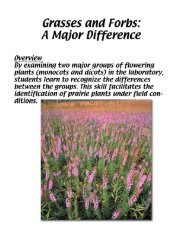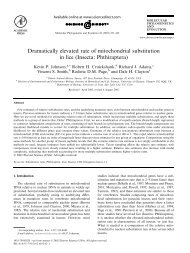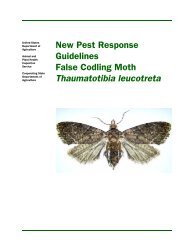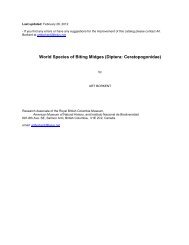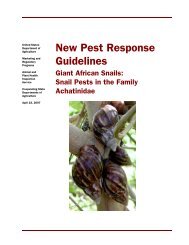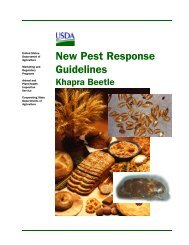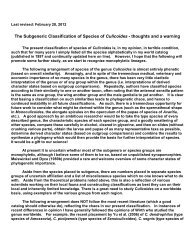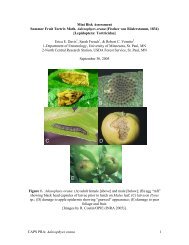Thaumatotibia leucotreta Mini Risk Assessment False codling moth
Thaumatotibia leucotreta Mini Risk Assessment False codling moth
Thaumatotibia leucotreta Mini Risk Assessment False codling moth
- No tags were found...
You also want an ePaper? Increase the reach of your titles
YUMPU automatically turns print PDFs into web optimized ePapers that Google loves.
Appendix C. Taxonomy of <strong>Thaumatotibia</strong> <strong>leucotreta</strong> (Meyrick) and relatedTortricidae (prepared by M. DaCosta).The species name <strong>leucotreta</strong> was removed from the genus Cryptophlebia and placed in<strong>Thaumatotibia</strong> by Komai (1999). The genus <strong>Thaumatotibia</strong> Zacher (1915) was not placedin a family when established, and was instead placed as a synonym of CryptophlebiaWalsingham (1899) (Nye and Fletcher 1991). Species of <strong>Thaumatotibia</strong> andCryptophlebia are similar to each other externally and the two genera are related to eachother. Komai (1999) lists the following characters common to both genera:1) forewing broad (male broader than female), with a blackish triangularpretornal patch and with an accessory cell of chorda small or absent (chordacoincident with the margin of the discal cell)2) hindwing with a short discal cell, especially in males3) eighth tergite (and sometimes preceeding tergites) with a small patch of longscales4) valva with a patch of very long, curled scales on the outer surface of thecucullus5) tenth abdominal segment of pupa with a pair of strong spines along anal rise.<strong>Thaumatotibia</strong> can be distinguished from Cryptophlebia on the basis of the followingcharacters:1) eighth tergite in male with a broadly sclerotized plate with convex posteriormargin and laterally produced into curved points2) sterigma indicated by an ovate or rectangular sclerite connecting posteriorlywith a pair of ovate granulations with modified scales3) corpus bursa with granular patch at juncture of ductus bursae.The species <strong>leucotreta</strong> was placed in one of two species groups in <strong>Thaumatotibia</strong> byKomai (1999), the <strong>leucotreta</strong>-group, which is distinguished from the other species group,the chaomorpha-group, by (1) the presence of tufts of modified scales on the inner side ofthe hindtibia (usually), (2) an enlarged inner apical spur and (3) “normal” juxta.According to Bradley et al. (1979), male T. <strong>leucotreta</strong> are distinguished from otherspecies by the specialized hindwing, which is slightly reduced and has a circular pocketof fine hair-like black scales overlaid with broad weakly shining whitish scales in the analangle, and its heavily tufted hind tibia.Descriptions of the external morphology as well as the genitalia of <strong>Thaumatotibia</strong><strong>leucotreta</strong> (Meyrick) are provided.Synonyms (from Bradley et al. 1979, Nye and Fletcher 1991, Komai 1999)At the generic level:<strong>Thaumatotibia</strong> Zacher,1915: 529-Heppner, 1980: 34 (as synonym of Cryptophlebia).Type species: <strong>Thaumatotibia</strong> roerigii Zacher, 1915 [=Argyroploce <strong>leucotreta</strong> Meyrick,1913] by monotypy• Argyroploce Hübner, [1825]CAPS PRA: <strong>Thaumatotibia</strong> <strong>leucotreta</strong> 19



